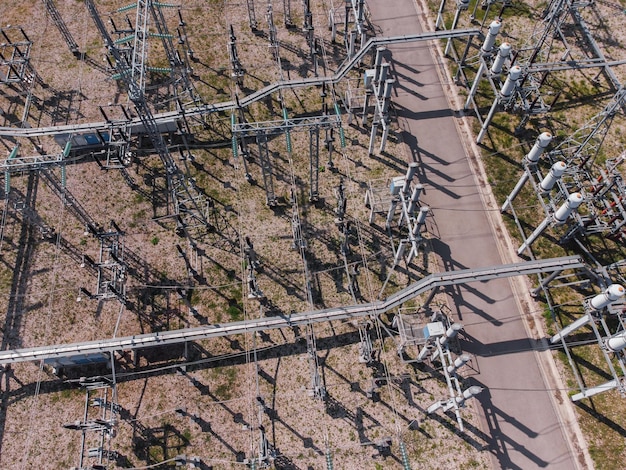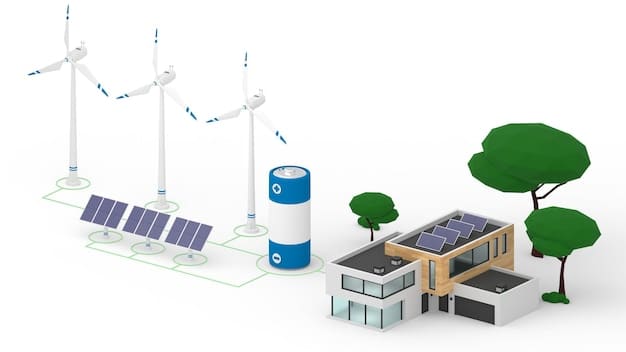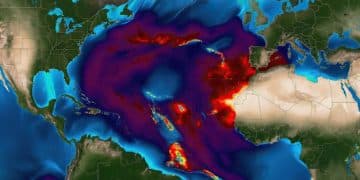US Power Grid: Extreme Weather Solutions for 2025

The US power grid faces increasing challenges from extreme weather events, necessitating urgent and comprehensive solutions by 2025 that encompass infrastructure upgrades, renewable energy integration, and advanced resilience technologies to ensure reliable power delivery.
The relentless escalation of extreme weather events, from blistering heatwaves to devastating hurricanes and crippling winter storms, casts a long shadow over the stability of the US power grid. This critical infrastructure, the very backbone of modern life, is increasingly vulnerable, leading to widespread outages, economic disruption, and significant human hardship. Understanding the impact of extreme weather on the US power grid and what are the solutions for 2025 is not just an academic exercise but an urgent imperative for national security and societal well-being.
The escalating threat of extreme weather events
The United States has witnessed a dramatic increase in the frequency and intensity of extreme weather events over recent decades. This trend is not merely anecdotal; scientific data, including reports from the National Oceanic and Atmospheric Administration (NOAA) and the Intergovernmental Panel on Climate Change (IPCC), unequivocally points to a future defined by more volatile climate patterns. These events, ranging from prolonged droughts to torrential downpours, present unique and complex challenges to the aging power grid, which was largely designed for a more stable climate.
When we consider the diverse range of extreme weather phenomena, the vulnerabilities of the grid become starkly evident. Hurricanes and tropical storms bring high winds and flooding, toppling transmission towers and submerging substations. Intense heatwaves push demand for air conditioning to unprecedented levels, straining generation capacity and causing equipment to overheat. Conversely, severe winter storms, like the one that crippled Texas in 2021, can freeze power plants and transmission lines, leading to widespread outages. Wildfires, often exacerbated by drought and high winds, destroy power lines and equipment, sometimes even being sparked by grid infrastructure itself.
Each type of weather event poses distinct threats, but they all converge on a single point: the erosion of grid resilience. The interconnected nature of the grid means that a failure in one region caused by a specific weather event can cascade into broader disruptions, affecting millions. The economic costs alone are staggering, running into billions of dollars annually from lost productivity, damaged infrastructure, and recovery efforts. Beyond the financial implications, the human cost, particularly in vulnerable communities that rely on electricity for crucial medical equipment or simply for heating and cooling, is immeasurable. The urgent need to adapt the grid to these evolving threats is clear, requiring foresight and immediate action.
Infrastructure vulnerabilities: An aging system under pressure
The current US power grid, a vast and complex network of generation, transmission, and distribution, is a product of different eras, with significant portions of its infrastructure dating back decades. This aging system, while revolutionary in its time, was never designed to withstand the intensity and frequency of the extreme weather events now becoming commonplace. Its inherent vulnerabilities are multifaceted, spanning from the generation plants themselves to the last-mile distribution lines that reach homes and businesses.
Consider the transmission lines, those omnipresent towers and wires that stretch across the landscape. Many of these lines are exposed, making them susceptible to damage from falling trees, ice accumulation, and high winds. Substations, critical nodes where voltage is transformed for distribution, are often located in flood-prone areas, leaving them vulnerable to inundation. Distribution lines, which deliver power directly to consumers, are frequently overhead, exposing them to the direct impact of storms, often leading to prolonged local outages.
The reliance on centralized generation also presents a weakness. If a large power plant goes offline due to extreme weather, the ripple effect can be extensive, affecting vast areas. Furthermore, the communication and control systems that manage the grid can also be compromised by severe weather, hindering efforts to reroute power or perform necessary repairs. Addressing these systemic vulnerabilities requires a comprehensive approach, from hardening existing components to strategically relocating critical assets. It demands a shift from reactive repairs to proactive resilience measures, ensuring that the grid can not only withstand but also quickly recover from the shocks delivered by an increasingly volatile climate.
Technological innovations for enhanced grid resilience
The challenge posed by extreme weather to the US power grid is immense, but so too is the innovation potential. A new wave of technologies is emerging, offering promising solutions to bolster grid resilience and ensure a more stable power supply in the face of escalating climatic threats. These innovations span various aspects of the grid, from enhanced forecasting to advanced energy storage, each playing a vital role in building a more robust system.
Advanced forecasting and predictive analytics
One of the most immediate and impactful innovations lies in the realm of predictive intelligence. Utilizing sophisticated weather models, satellite data, and even sensor networks embedded within the grid, utilities can now gain unprecedented foresight into potential weather impacts. This allows for:
- Proactive resource deployment: Crews and equipment can be pre-positioned in anticipated impact zones.
- Pre-emptive grid adjustments: Power can be rerouted or sections can be temporarily de-energized to minimize damage.
- Optimized maintenance schedules: Infrastructure most vulnerable to upcoming weather events can be prioritized for upgrades or repairs.
This proactive stance, driven by data, marks a significant departure from traditional reactive responses.
Microgrids and distributed energy resources (DERs)
The concept of microgrids offers a powerful antidote to the vulnerabilities of a centralized system. These localized grids, capable of operating independently from the main grid – often referred to as “islanding” – can provide power to critical facilities such as hospitals, emergency shelters, and essential services even when the main grid is down. They typically integrate various distributed energy resources (DERs):
- Renewable sources like solar panels and wind turbines.
- Battery energy storage systems (BESS).
- Small-scale generators.
The proliferation of microgrids enhances local resilience, reducing the scope of large-scale outages.
Advanced energy storage solutions
Energy storage, particularly large-scale battery systems, is a game-changer. These systems can store excess power generated during off-peak hours or from intermittent renewable sources and then discharge it when demand is high or during outages. This not only balances the grid but also provides a critical buffer during extreme weather events, ensuring a continuous supply of electricity for extended periods.
Smart grid technologies and automation
The modernization of the grid through smart technologies enables real-time monitoring, fault detection, and automated responses. Sensors, smart meters, and advanced communication networks allow utilities to pinpoint issues quickly and even self-heal sections of the grid by automatically rerouting power around damaged areas. This significantly reduces restoration times and minimizes the affected population.
Undergrounding power lines
While costly and challenging to implement on a large scale, burying power lines protects them from wind, ice, and falling trees, which are common causes of outages during storms. This is a targeted solution often applied in highly vulnerable or critical areas.
The integration of these diverse technologies, often in conjunction, represents a multi-pronged strategy to build a truly resilient power grid. It’s a move towards a smarter, more decentralized, and adaptable system capable of withstanding the rigors of an increasingly unpredictable climate.

Policy frameworks and regulatory considerations
The technological solutions for enhancing grid resilience, while critical, cannot be implemented effectively without robust policy frameworks and supportive regulatory environments. Government bodies, utility commissions, and legislative entities play a pivotal role in shaping the future of the US power grid, guiding investments, and setting the standards for resilience. The fragmented regulatory landscape in the United States, with its mix of federal, state, and local oversight, adds a layer of complexity but also offers opportunities for tailored approaches.
At the federal level, agencies like the Department of Energy (DOE) and the Federal Energy Regulatory Commission (FERC) are instrumental in promoting grid modernization and resilience. Initiatives such as research grants for advanced energy technologies, guidelines for cybersecurity, and interstate transmission coordination are all part of this top-down effort. However, the practical implementation of many resilience measures often falls to state public utility commissions (PUCs) and local governments. These entities determine how utilities can recover costs for infrastructure upgrades, define incentives for renewable energy adoption, and mandate resilience standards specific to their geographic vulnerabilities.
One significant policy challenge is cost recovery. Utilities typically need approval from state regulators to pass the costs of infrastructure hardening and technological investments onto consumers through electricity rates. Striking a balance between ensuring grid reliability and keeping electricity affordable for ratepayers is a constant tightrope walk. Regulators must be convinced of the long-term benefits of these investments, demonstrating that proactive resilience measures are ultimately more cost-effective than repeatedly repairing damaged infrastructure after major weather events.
Furthermore, policy must address the integration of new technologies like distributed energy resources. Regulatory frameworks need to evolve to facilitate the seamless connection of solar panels, battery storage, and microgrids to the main grid, ensuring fair compensation for excess power and maintaining grid stability. This includes establishing clear interconnection standards and market mechanisms that value resilience and reliability. Incentives for private investment in grid resilience, such as tax credits or streamlined permitting processes, could also accelerate adoption.
The shift towards a more resilient grid also necessitates a re-evaluation of existing planning processes. Traditional grid planning often focuses on reliability based on historical weather data. Future policies must mandate forward-looking assessments that incorporate climate change projections and the increasing frequency of extreme weather. This might involve stress testing the grid against various extreme weather scenarios and developing adaptive management strategies. Collaborative efforts between federal, state, and local entities are essential to create a cohesive and effective national strategy for grid resilience, transcending political divides to prioritize a secure and reliable energy future.
Current initiatives and future outlook for 2025
As the urgency to address extreme weather impacts on the US power grid intensifies, various initiatives are already underway, setting the stage for significant advancements by 2025. These efforts, spanning government programs, utility investments, and collaborative research, aim to build a more resilient and adaptable energy infrastructure. While the journey is ongoing, the near-term outlook is one of accelerated progress and strategic focus.
One key area of focus involves significant investment in grid hardening. Utilities across the nation are actively replacing aging equipment, reinforcing transmission towers, and implementing vegetation management programs to minimize the risk of tree-related outages. Some are strategically burying power lines in vulnerable areas, though this remains an expensive and complex undertaking. These physical upgrades, while often less glamorous than high-tech solutions, form the foundational backbone of a more robust grid.
Government legislation and funding are also playing a crucial role. The Infrastructure Investment and Jobs Act (IIJA), for instance, has allocated billions of dollars towards grid modernization, resilience projects, and clean energy deployment. These funds are enabling states and utilities to pursue projects that might otherwise be financially unfeasible, catalyzing innovation and implementation. The Department of Energy’s Grid Modernization Initiative also continues to fund research and development in areas like advanced materials, energy storage, and cybersecurity.
By 2025, we can expect several key trends to accelerate:
- Increased deployment of smart grid technologies: More utilities will adopt advanced metering infrastructure, automated fault location, isolation, and service restoration (FLISR) systems, and real-time monitoring systems to enhance grid visibility and control.
- Growth in distributed energy resources: The proliferation of rooftop solar, community solar, and battery storage systems will continue, creating more localized power generation and storage capabilities that can support the grid during peak demand or outages.
- Expanded microgrid development: More critical facilities and communities will implement microgrids, often powered by renewables and storage, to ensure uninterrupted service during extreme weather events.
- Enhanced data analytics and AI for grid management: Utilities will increasingly leverage artificial intelligence and machine learning to analyze vast datasets on weather patterns, grid performance, and equipment health, enabling more accurate predictions of failures and optimized maintenance schedules.
- Inter-regional transmission expansion: Efforts to build out resilient interstate transmission lines will gain momentum, allowing for more efficient power sharing and greater flexibility during regional power disruptions.
These initiatives collectively represent a paradigm shift from a reactive to a proactive approach to grid management. While a fully resilient grid is a long-term goal, the advancements anticipated by 2025 will significantly mitigate the impacts of extreme weather, laying a stronger foundation for a reliable and sustainable energy future for the United States.
Community engagement and public awareness
While technological advancements and policy shifts are critical for strengthening the US power grid against extreme weather, the role of community engagement and public awareness cannot be overstated. A truly resilient energy system involves not just infrastructure but also informed citizens who understand their role in energy consumption, preparedness, and local grid initiatives. Without public understanding and support, even the most innovative solutions may fall short of their potential.
One crucial aspect of community engagement is fostering a culture of energy efficiency and conservation. Educating the public about how their energy consumption habits impact grid stability, especially during peak demand periods exacerbated by extreme temperatures, can lead to behavioral changes that reduce strain on the system. Simple measures, like adjusting thermostats or using energy-intensive appliances during off-peak hours, can collectively have a significant positive effect. Utilities and government agencies can play a key role by providing clear guidance, incentives, and accessible information on these practices.
Furthermore, public awareness campaigns are essential for informing communities about emergency preparedness during power outages. This includes advising residents on how to assemble emergency kits, safely operate generators, and understand communication protocols during widespread disruptions. Clear and consistent communication from utilities before, during, and after extreme weather events builds trust and helps manage expectations, ensuring that communities are not caught off guard.
The rise of distributed energy resources also necessitates greater community involvement. Programs that encourage homeowners and businesses to install rooftop solar, battery storage, or participate in demand response initiatives can empower individuals to contribute to local grid resilience. Community-owned solar projects or microgrids, in particular, require strong local leadership and participatory planning to succeed, ensuring that solutions align with community needs and priorities. This bottom-up approach complements top-down infrastructure investments, creating a more robust and democratized energy landscape.
In sum, fostering a well-informed and engaged public transforms passive consumers into active participants in grid resilience. It creates a feedback loop where community needs inform policy, and public support drives the successful implementation of new technologies. As the nation grapples with the increasing severity of extreme weather, a robust and resilient power grid will depend not only on technological prowess but also on the collective understanding and collaboration of the communities it serves.
Funding and financing resilience initiatives
The ambitious goal of fortifying the US power grid against the growing threat of extreme weather events requires substantial financial investment. While the benefits of a resilient grid—reduced outage costs, enhanced public safety, and economic stability—are clear, securing and allocating the necessary funding presents a complex challenge. Various mechanisms, both public and private, are essential to finance the widespread upgrades and technological integrations needed by 2025 and beyond.
Traditionally, grid infrastructure investments have been funded through utility rates, where the costs are passed on to consumers. However, the scale of resilience-focused upgrades often exceeds what can be realistically absorbed by ratepayers alone without significant bill increases. This necessitates a multi-pronged approach to financing. Federal funding, as seen with initiatives like the Infrastructure Investment and Jobs Act (IIJA), represents a critical source of capital. These government allocations can provide grants, loans, and other financial incentives for states, municipalities, and utilities to undertake large-scale resilience projects, from hardening transmission lines to deploying advanced battery storage.
State-level clean energy and resilience funds also contribute, often supported by carbon cap-and-trade programs, clean energy surcharges, or bond issuances. These funds can be directed towards specific projects that demonstrate climate resilience benefits, such as microgrid development in critical areas or the integration of distributed renewable energy sources. Furthermore, specialized resilience bonds or green bonds are emerging as a way for utilities and states to raise capital from investors specifically for environmentally beneficial infrastructure projects.
Private sector investment is equally crucial. Utilities, through their own capital expenditures, are increasingly prioritizing resilience in their long-term planning. This includes investing in smart grid technologies, undergrounding lines where feasible, and deploying more robust equipment. Public-private partnerships (PPPs) can also play a significant role, bringing together governmental bodies and private companies to share the financial risks and rewards of large infrastructure projects. This model can accelerate the deployment of innovative solutions by leveraging private sector expertise and financing.
Moreover, regulatory frameworks that incentivize resilience investments are vital. State utility commissions can approve rate structures that allow utilities to recover costs for resilience measures in a timely manner, provided these investments are prudently made and demonstrate clear benefits to ratepayers. Performance-based regulation (PBR) is another approach, where utilities are rewarded for achieving specific resilience outcomes, rather than simply recovering costs for expenditures. This encourages efficient and effective deployment of funds.
Ultimately, financing grid resilience is an investment in future stability and security. It requires a collaborative effort from federal, state, and local governments, coupled with robust private sector engagement and consumer support. By strategically deploying a mix of these funding and financing mechanisms, the United States can build a power grid capable of withstanding the intensifying impacts of extreme weather, ensuring reliable energy delivery for generations to come.
| Key Point | Brief Description |
|---|---|
| ⛈️ Extreme Weather Impact | Increased frequency and intensity challenging aging US grid. |
| 💡 Tech Solutions | Microgrids, storage, AI, and smart grid automation bolster resilience. |
| 💰 Funding Needs | Requires federal, state, and private investments for upgrades. |
| 🧑🤝🧑 Community Role | Public awareness and engagement are vital for collective resilience. |
Frequently asked questions about grid resilience
▼
The US power grid’s vulnerability stems from its extensive age and original design, which predates current climate patterns. Much of its infrastructure, including overhead lines and substations, was not built to withstand the increased intensity and frequency of hurricanes, heatwaves, winter storms, and wildfires now impacting the nation.
▼
A microgrid is a localized energy system capable of operating independently from the main grid. Powered by diverse sources like solar, batteries, and small generators, it provides power to critical facilities during widespread outages caused by extreme weather, enhancing local resilience and preventing cascading failures.
▼
Smart grid technologies enable real-time monitoring and automated responses across the network. Sensors and communication systems quickly detect faults, allowing for automatic rerouting of power around damaged sections. This “self-healing” capability significantly reduces restoration times and minimizes the number of affected customers during weather events.
▼
Policy and regulation are crucial for guiding investments and setting standards. Federal and state agencies establish frameworks for infrastructure upgrades, incentivize renewable energy adoption, and determine how utilities can recover costs for resilience measures. They ensure that grid modernization aligns with public safety and long-term energy goals.
▼
By 2025, significant advancements are anticipated, including broader deployment of smart grid technologies, increased adoption of microgrids and energy storage, enhanced data analytics using AI for predictive maintenance, and continued federal funding for infrastructure hardening. These efforts will create a more adaptable and robust grid.
Conclusion
The escalating intensity of extreme weather events poses an undeniable and growing threat to the reliability of the US power grid. Addressing this challenge by 2025 demands a multi-faceted and concerted effort that transcends traditional approaches. As explored, solutions range from tangible infrastructure upgrades and the strategic undergrounding of lines to the integration of cutting-edge technologies like advanced energy storage, AI-driven predictive analytics, and the widespread adoption of resilient microgrids. Crucially, the journey towards a more robust grid also hinges on supportive policy frameworks, diverse funding mechanisms, and active, informed community engagement. By embracing these solutions with urgency and collaboration, the United States can significantly enhance its energy security, ensuring that the power grid remains a steadfast backbone for communities and the economy, even in the face of an increasingly volatile climate.





